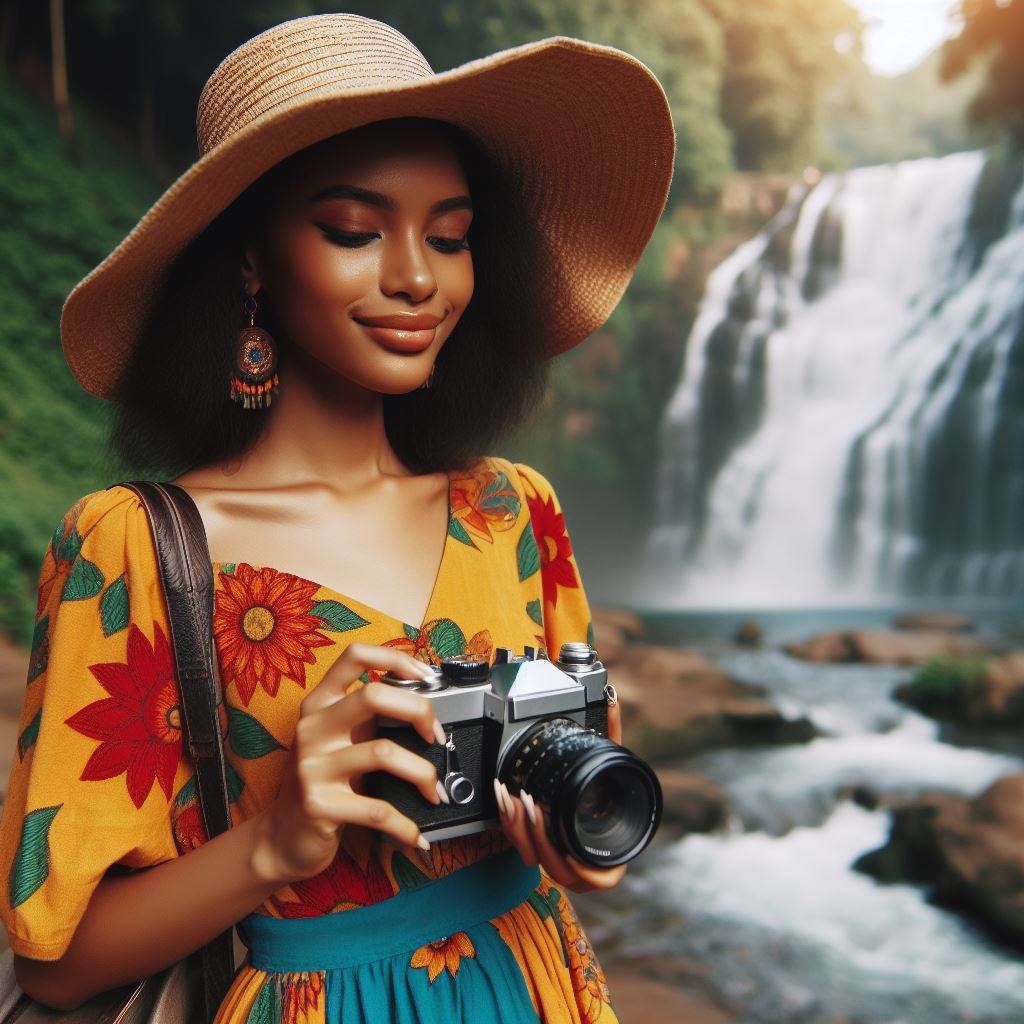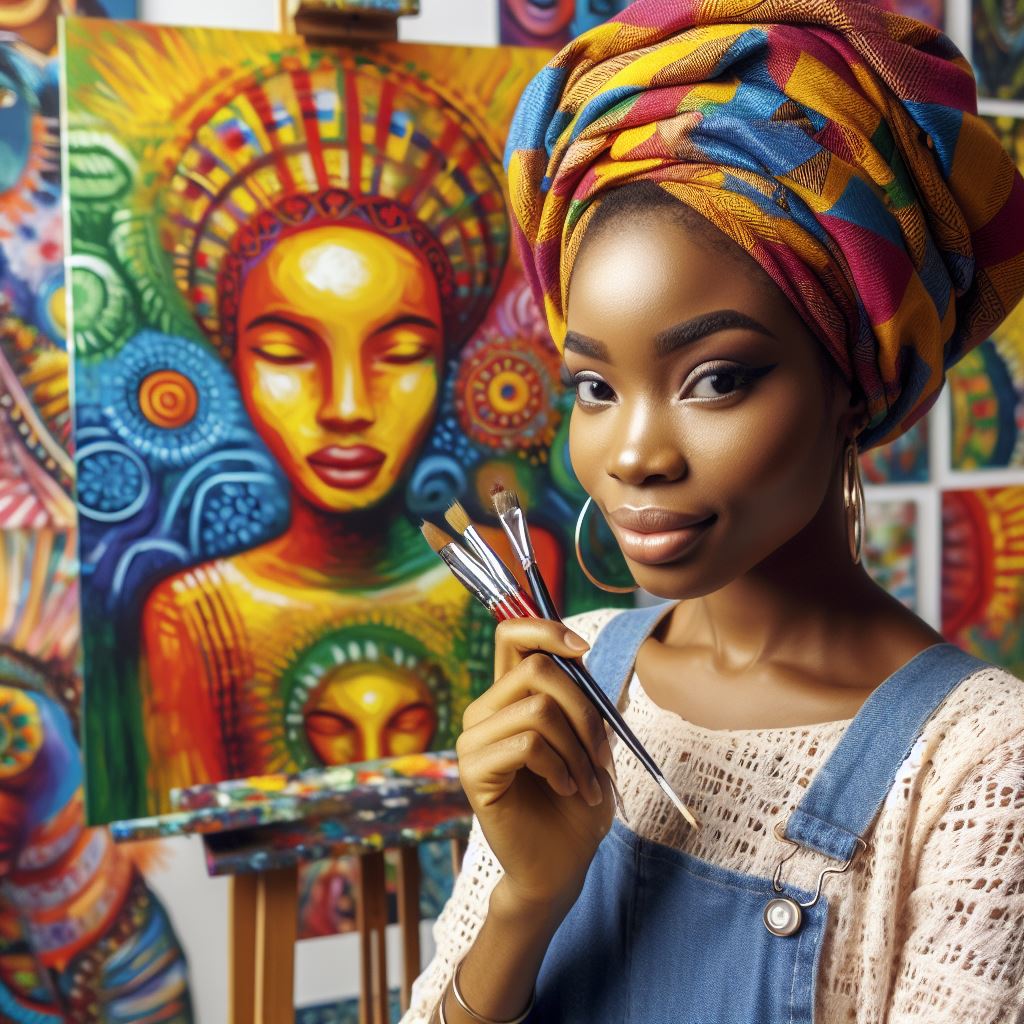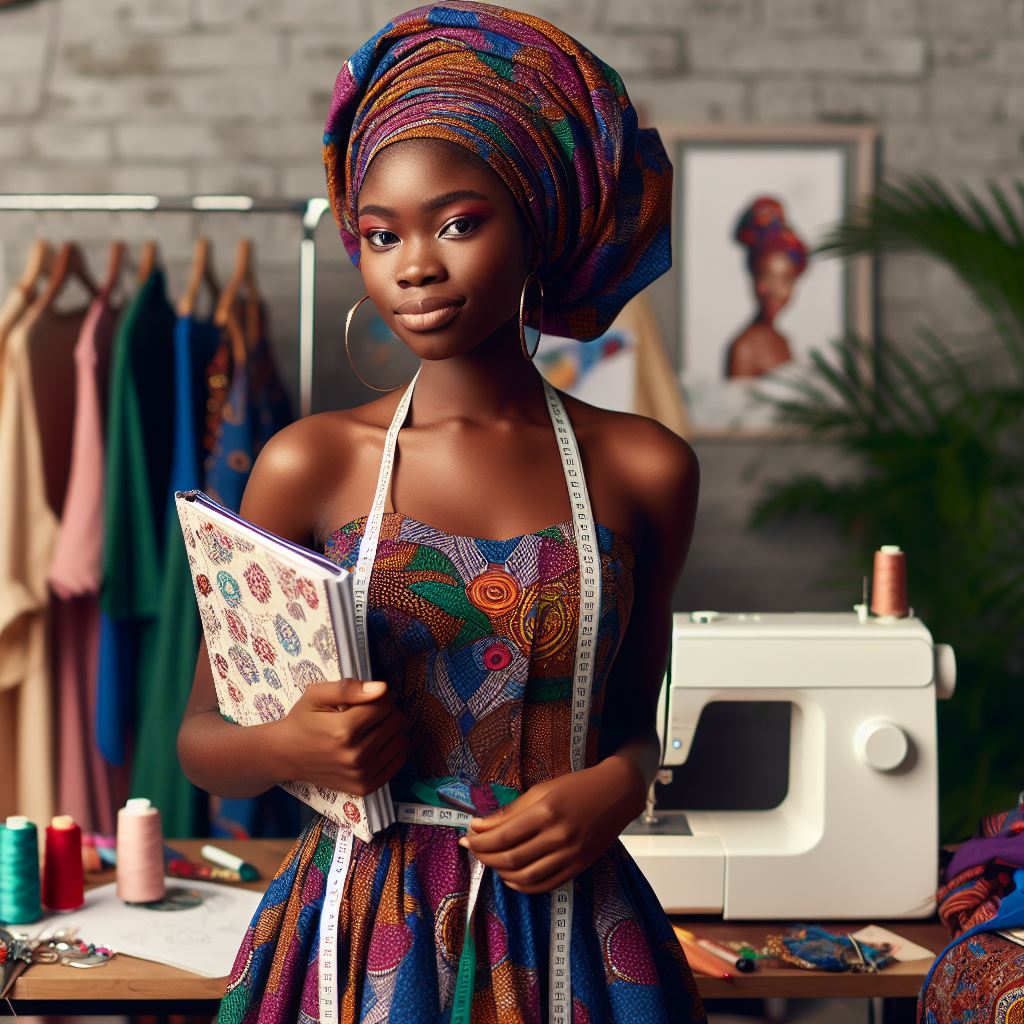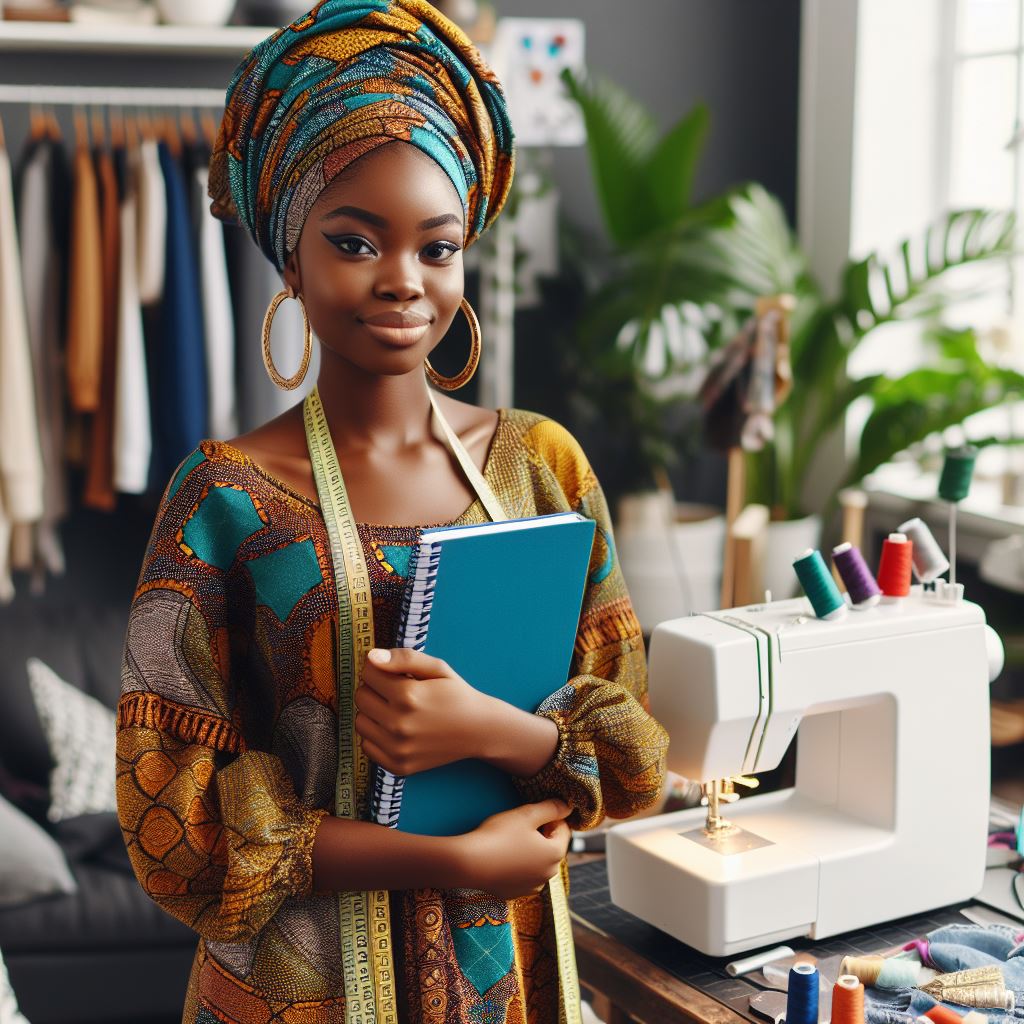Introduction
Nigerian art boasts a rich and diverse history. Ancient terracotta sculptures, traditional masks, and vibrant textiles highlight Nigeria’s artistic heritage. Over the centuries, Nigerian art has evolved, reflecting the country’s dynamic culture and history.
Brief History of Nigerian Art
Nigerian art dates back to the Nok civilization, famous for its terracotta sculptures. The Ife and Benin cultures produced intricate bronze and brass works, showcasing advanced metalworking skills.
Traditional art forms, such as Yoruba wood carvings and Igbo uli body paintings, remain influential today. Contemporary Nigerian art blends traditional and modern styles, creating unique and expressive works.
Importance of Photography in Capturing Nigerian Art
Photography plays a crucial role in documenting Nigerian art. It preserves art for future generations and promotes global appreciation.
Through photography, artists can share their work with a wider audience, increasing visibility and recognition. Photographs of Nigerian art capture the essence and details of each piece, highlighting craftsmanship and cultural significance.
Overview of What the Blog Post Will Cover
This blog post will explore the intersection of Nigerian art and photography. We will discuss how photographers document traditional and contemporary Nigerian art.
We will also highlight notable Nigerian photographers who have contributed to the art world. Additionally, we will provide tips for photographing art effectively. By the end of this post, you will understand the significance of photography in preserving and promoting Nigerian art.
Traditional Nigerian Art Forms
Generations have passed down a rich tapestry of diverse forms in traditional Nigerian art. From pottery to textile designs to sculptures, each art form tells a story of the country’s history, culture, and traditions.
Pottery
Pottery is one of the oldest art forms in Nigeria, with a history that dates back centuries. Nigerian pottery is known for its intricate designs, vibrant colors, and unique shapes.
Each piece of pottery narrates a unique story, from cooking vessels to ornate items for ceremonies and rituals.
- Pottery plays a significant role in Nigerian culture, with different regions having their own distinctive styles and techniques.
- Traditional Nigerian pottery is often hand-built using coiling or pinching techniques, creating both functional and decorative pieces.
- Photography captures Nigerian pottery’s beauty and intricacy, showcasing artisans’ skill and craftsmanship behind these pieces.
Textile Designs
Photography captures Nigerian pottery’s beauty and intricacy, showcasing artisans’ skill and craftsmanship behind these pieces. Nigerian textiles are known for their bold colors, geometric shapes, and symbolic motifs that have deep meanings in Nigerian society.
- In Nigeria, artisans create textile designs using techniques like batik, tie-dye, and weaving, reflecting regional traditions.
- These textiles are used in everyday clothing, ceremonial attire, and home decor, showcasing the diversity and creativity of Nigerian craftsmanship.
- Photography vividly showcases Nigerian textile designs, revealing their intricate details and vibrant hues to captivate viewers.
Sculptures
Traditional Nigerian art includes sculptures, showcasing intricate designs and cultural significance, contributing to aesthetics and heritage.
Nigerian sculptures encompass a wide range of materials, styles, and themes, each with its own symbolism and purpose.
- Traditional Nigerian art includes sculptures, showcasing intricate designs and cultural significance, contributing to aesthetics and heritage.
- The sculptures depict human figures, animals, mythical creatures, and abstract forms, reflecting Nigerian spiritual beliefs and cultural stories.
- Photography highlights the skill and creativity of Nigerian artists, capturing the detail and beauty of sculptures they create.
Traditional Nigerian art forms, including pottery, textile designs, and sculptures, actively preserve the country’s cultural heritage and artistic traditions.
Photography showcases these art forms to a wider audience, drawing attention to the beauty, craftsmanship, and cultural significance of Nigerian art.
Read: Exploring Semiotics in Communication Arts
Contemporary Nigerian Artists
Contemporary Nigerian artists shape the art scene with their talent and creativity, exploring new forms of expression. They include painters and sculptors, pushing boundaries.
Peju Alatise
Peju Alatise is a multi-talented artist who works with various mediums, including painting, sculpture, and installation art.
Her work often deals with themes of gender, identity, and social issues in Nigerian society. Through her powerful images and thought-provoking installations, she challenges viewers to think critically about the world around them.
Ndidi Emefiele
Ndidi Emefiele paints vibrant, colorful artworks exploring femininity, beauty, and cultural identity. She incorporates Nigerian fashion and pop culture, engaging modern audiences.
Victor Ehikhamenor
Victor Ehikhamenor is a versatile artist whose work spans painting, sculpture, and mixed media. His artwork often reflects on the complexities of Nigerian society and history, blending traditional motifs with contemporary themes.
Through his visually striking pieces, he invites viewers to question their preconceived notions and explore new perspectives.
How These Artists are Shaping the Art Scene in Nigeria
These artists are not only creating beautiful and thought-provoking artwork, but they are also actively shaping the art scene in Nigeria in several ways.
- They are challenging traditional notions of Nigerian art by exploring new forms of expression and pushing boundaries.
- They are engaging with contemporary issues and social themes, sparking important conversations and raising awareness.
- They are inspiring a new generation of artists and creatives to think critically and creatively about their work and its impact on society.
- They are gaining international recognition and acclaim, putting Nigerian art on the global stage and contributing to its growing reputation.
Overall, these contemporary Nigerian artists are not only creating visually stunning and intellectually stimulating artwork, but they are also playing a crucial role in shaping the future of Nigerian art and placing it firmly on the map of the global art world.
Read: Developing Critical Thinking in Language Arts
Photography as a Tool for Cultural Preservation
Photography plays a crucial role in capturing and preserving the rich art and culture of Nigeria.
Through the lens of a camera, photographers can document intricate details of art pieces, cultural practices, and traditional ceremonies that are significant to Nigerian heritage.
Discussing the role of photographers in documenting and preserving Nigerian art, it is essential to highlight their responsibility to accurately depict the essence of the country’s cultural diversity.
Photographers serve as storytellers, capturing moments that reflect the unique traditions and aesthetics of Nigeria.
Photographers also act as custodians of history, ensuring that the legacy of Nigerian art is not lost or forgotten. By photographing artifacts, sculptures, textiles, and other art forms, they contribute to the preservation of Nigeria’s cultural heritage for future generations.
Examples of Photography Preserving Nigerian Cultural Heritage
- Photographing Adire Eleko: Adire Eleko is a traditional Nigerian textile art form that involves intricate patterns created using cassava starch. By capturing the detailed designs of Adire Eleko pieces, photographers help to showcase this unique aspect of Nigerian culture.
- Documenting Gele Styles: Gele is a headpiece worn by Nigerian women for special occasions. Photographers document the different styles and techniques of tying Gele, preserving the tradition and beauty of this cultural practice.
- Capturing Traditional Dance Performances: Nigerian dance forms are an integral part of the country’s cultural heritage. Photographers document these vibrant performances, showcasing the energy and storytelling elements of traditional Nigerian dance.
- Archiving Indigenous Artifacts: Many photographers work with museums and cultural institutions to photograph indigenous artifacts such as masks, sculptures, and pottery. These images are invaluable in preserving the history and significance of Nigerian art.
Most importantly, photography serves as a powerful tool for cultural preservation in Nigeria.
Photographers play a crucial role in documenting and showcasing the diverse art forms, traditions, and practices that make up the country’s rich cultural heritage.
Through their lens, they capture moments that not only preserve the past but also inspire future generations to appreciate and cherish Nigerian art and culture.
Read: Student Experiences: Life in Communication Arts

Challenges and Opportunities in Exploring Nigerian Art Through Photography
When it comes to exploring Nigerian art through photography, there are several challenges that photographers may face along the way.
These challenges can range from access to art galleries, funding, and acquiring the right equipment. However, amidst these challenges, there are also numerous opportunities for photographers to delve into the rich world of Nigerian art.
Challenges
- Access to Art Galleries: One of the primary challenges photographers face is gaining access to art galleries where they can capture stunning shots of Nigerian art. Some galleries may have restrictive policies or limited hours, making it difficult for photographers to visit and photograph the artwork.
- Lack of Funding: Another common challenge is the lack of funding to support photography projects focused on Nigerian art. Without financial backing, photographers may struggle to afford travel expenses, equipment, and other necessary resources to effectively capture the beauty of Nigerian art.
- Inadequate Equipment: Having the right equipment is essential for producing high-quality photographs of Nigerian art. Unfortunately, not all photographers have access to advanced cameras, lenses, and lighting gear, which can hinder their ability to showcase the intricate details and colors of the artwork.
Opportunities
- Cultural Exchange: Exploring Nigerian art through photography provides a unique opportunity for photographers to engage in a cultural exchange. By capturing the essence of Nigerian art, photographers can gain a deeper understanding of the country’s rich cultural heritage and share it with a global audience.
- Promotion of Nigerian Art: Through photography, photographers can play a crucial role in promoting Nigerian art on a global scale. By showcasing the diversity and talent of Nigerian artists, photographers can help raise awareness and appreciation for the country’s vibrant art scene.
- Collaboration with Artists: Collaborating with Nigerian artists can open up new opportunities for photographers to create compelling and meaningful art projects. By working closely with artists, photographers can gain insight into their creative process and produce visually captivating images that tell a powerful story.
Resources and Tips for Aspiring Photographers
- Attend Art Exhibitions: One of the best ways to get inspired and capture stunning images of Nigerian art is to attend art exhibitions and galleries. These events provide a wealth of opportunities to network with artists, curators, and fellow photographers.
- Invest in Quality Equipment: While it’s important to work with what you have, investing in quality photography equipment can significantly enhance the quality of your images. Look for cameras, lenses, and lighting tools that will help you capture the intricate details and vibrant colors of Nigerian art.
- Build a Strong Portfolio: Building a strong portfolio showcasing your work with Nigerian art can help you attract potential clients and collaborators. Focus on creating a diverse range of photographs that highlight your unique style and expertise in capturing the beauty of Nigerian art.
By addressing the challenges and seizing the opportunities presented in exploring Nigerian art through photography, photographers can create impactful and visually stunning images that celebrate the beauty and cultural significance of Nigerian art.
Read: Communication Arts: Balancing Theory and Practice
Impact of Photography on Nigerian Art Industry
Photography plays a significant role in the Nigerian art industry, contributing to its growth in various ways. This medium enables artists to capture and showcase the rich cultural heritage, traditions, and contemporary expressions of Nigeria.
- Preservation of Nigerian Culture: Through photography, Nigerian artists can document and preserve aspects of their culture that may be at risk of fading away. This helps to create a visual archive for future generations.
- Exploration of Identity: Photographers in Nigeria explore themes of identity, belonging, and heritage through their work. They shed light on what it means to be Nigerian and capture the essence of the Nigerian people.
- Innovation and Creativity: Photography allows for experimentation and innovation in creating art. Nigerian photographers blend traditional techniques with modern technology to produce unique and compelling images.
Contributions to the Growth of Nigerian Art Industry
Photography has played a crucial role in advancing the Nigerian art industry by providing new avenues for artists to express themselves and reach a broader audience.
The following points highlight how photography is contributing to the growth of the Nigerian art scene:
- Diversification of Art Forms: Photography has diversified the art forms represented in Nigeria, attracting new audiences and collectors to the vibrant art scene. This diversity has enriched the cultural landscape of the country.
- Cross-Cultural Exchange: Through photography, Nigerian artists have been able to engage in cross-cultural exchanges with their counterparts from around the world. This exchange of ideas and perspectives has influenced the creative process and pushed boundaries in art making.
- Professional Development: Photography has provided opportunities for artists to develop their skills, gain recognition, and establish themselves in the art market. This has led to the professionalization of the art sector in Nigeria and the growth of a thriving artistic community.
Influence of Photography in Promoting Nigerian Art Globally
Photography has been instrumental in promoting Nigerian art globally, helping to showcase the country’s artistic talents and cultural richness on the international stage.
The following points illustrate the influence of photography in promoting Nigerian art worldwide:
- Exhibition Opportunities: Nigerian photographers have had the opportunity to exhibit their work in international art galleries, museums, and biennales, gaining exposure and recognition on a global scale. This exposure has elevated the profile of Nigerian art in the international art community.
- Online Platforms: The digital age has provided Nigerian photographers with online platforms to showcase their work to a global audience. Social media, websites, and online galleries have become essential tools for promoting Nigerian art and connecting with art enthusiasts worldwide.
- Cultural Diplomacy: Photography serves as a form of cultural diplomacy, representing Nigeria’s cultural identity and heritage to the world. Through visual imagery, Nigerian photographers communicate universal themes of humanity, resilience, and creativity that resonate with audiences worldwide.
Success Stories of Photographers in the Nigerian Art Scene
Several photographers have made a mark in the Nigerian art scene, showcasing their talent, creativity, and cultural insights through their work. The following success stories exemplify the impact of photography on the Nigerian art industry:
- TY Bello: A renowned photographer, TY Bello is known for her striking portraits and documentary photography, capturing the essence of Nigerian society and culture. Her work has been exhibited internationally and has received critical acclaim.
- Kelechi Amadi-Obi: Kelechi Amadi-Obi is a celebrated Nigerian photographer known for his fashion photography and editorial work. His innovative approach to photography has earned him numerous awards and accolades, establishing him as a prominent figure in the Nigerian art scene.
- George Osodi: George Osodi is a photojournalist whose powerful images document social issues, environmental challenges, and cultural traditions in Nigeria. His thought-provoking work has been featured in major international publications and exhibitions, raising awareness of important issues in Nigerian society.
Overall, photography continues to play a vital role in shaping and advancing the Nigerian art industry, providing a platform for artists to express their creativity, preserve their cultural heritage, and connect with a global audience.
Through innovative techniques, cross-cultural exchanges, and exhibition opportunities, Nigerian photographers are making a significant impact on the art scene, both locally and internationally.
Conclusion
In closing, exploring Nigerian art through photography offers a unique and insightful perspective. It allows us to appreciate the rich culture and heritage of Nigeria in a visually captivating way.
By capturing the diversity and beauty of Nigerian art through photography, we can support local artists and promote their work on a global scale.
Engaging with Nigerian art not only enriches our cultural understanding but also helps to sustain and preserve these artistic traditions for future generations.
We encourage readers to immerse themselves in the world of Nigerian art, whether through visiting galleries, attending art exhibitions, or supporting local artisans. It is a wonderful way to connect with the soulful and vibrant artistic expressions of Nigeria.
For those interested in delving deeper into Nigerian art through photography, we recommend exploring books, online platforms, and art galleries dedicated to Nigerian artists.
This will provide an in-depth look into the various styles, themes, and influences that shape Nigerian art today.
In essence, Nigerian art offers a treasure trove of creativity and inspiration waiting to be discovered through the lens of photography.
Let’s continue to celebrate and champion the artistic talents of Nigeria by exploring and engaging with their captivating art forms. Together, we can help preserve and promote Nigerian art for generations to come.




